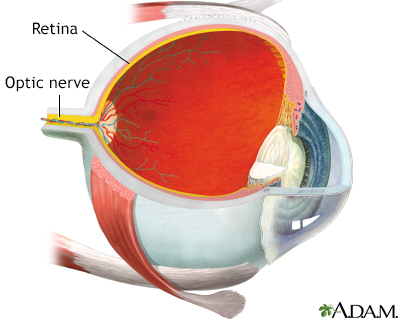Pregnancy SmartSiteTM
Laser coagulation; Laser eye surgery; Photocoagulation; Laser photocoagulation - diabetic eye disease; Laser photocoagulation - diabetic retinopathy; Focal photocoagulation; Scatter (or pan retinal) photocoagulation; Proliferative retinopathy - laser; PRP - laser; Grid pattern photocoagulation - laser DefinitionLaser photocoagulation is eye surgery using a laser to shrink or destroy abnormal structures in the retina, or to intentionally cause scarring that can help certain eye conditions. DescriptionYour eye doctor will perform this surgery at an outpatient or office setting. Photocoagulation takes place by using the laser to create a microscopic burn in the target tissue. The laser spots are usually applied in 1 of 3 patterns. Before the procedure, you will be given eye drops to dilate your pupils. Rarely, you will get a shot of a local anesthetic. The shot may be uncomfortable. You will be awake and pain-free during the procedure.
Why the Procedure Is PerformedDiabetes can harm the eyes by causing diabetic retinopathy. It is one of the most common eye diseases that needs laser photocoagulation. It can damage the retina, the back part of your eye. The most severe form of the condition is proliferative diabetic retinopathy, in which abnormal vessels grow on the retina. Over time, these vessels can bleed or cause scarring of the retina. In laser photocoagulation for diabetic retinopathy, laser energy is aimed at certain areas of the retina to prevent abnormal vessels from growing or shrinking those that may already be there. Sometimes it is done to make edema fluid in the center of the retina (macula) go away. This surgery may also be used to treat the following eye problems:
RisksSince each pulse of the laser causes a microscopic burn in the retina, you may develop:
If not treated, diabetic retinopathy can cause permanent blindness. Before the ProcedureSpecial preparations are rarely needed before laser photocoagulation. Usually, both eyes will be dilated for the procedure. Arrange to have someone to drive you home after the procedure. After the ProcedureYou vision will be blurry for the first 24 hours. You may see floaters, but these will subside over time. If your treatment was for macular edema, your vision may seem worse for a few days. Outlook (Prognosis)Laser surgery works best in the early stages of vision loss. It cannot bring back lost vision. However, it can greatly reduce the risk for permanent vision loss. Managing your diabetes can help prevent diabetic retinopathy. Follow your eye doctor's advice on how to protect your vision. Have eye exams as often as recommended, usually once every 1 to 2 years. ReferencesAmerican Academy of Ophthalmology website. Diabetic macular edema: diagnosis and management. www.aao.org/eyenet/article/diabetic-macular-edema-diagnosis-and-management. Updated May 2021. Accessed February 21, 2024. Brownlee M, Aiello LP, Sun JK, et al. Complications of diabetes mellitus. In: Melmed S, Auchus RJ, Goldfine AB, Koenig RJ, Rosen CJ, eds. Williams Textbook of Endocrinology. 14th ed. Philadelphia, PA: Elsevier; 2020:chap 37. Flaxel CJ, Adelman RA, Bailey ST, et al. Diabetic retinopathy preferred practice pattern. Ophthalmology. 2020;127(1):P66-P145. PMID: 31757498 pubmed.ncbi.nlm.nih.gov/31757498/. Silva PS, Salongcay RP. Diabetic retinopathy. In: Yanoff M, Duker JS, eds. Ophthalmology. 6th ed. Philadelphia, PA: Elsevier; 2023:chap 6.18. Wiley HE, Chew EY, Ferris FL. Nonproliferative diabetic retinopathy and diabetic macular edema. In: Sadda SR, Sarraf D, Freund KB et al, eds. Ryan's Retina. 7th ed. Philadelphia, PA: Elsevier; 2023:chap 49. | ||
| ||
Review Date: 1/29/2024 Reviewed By: Audrey Tai, DO, MS, Athena Eye Care, Mission Viejo, CA. Also reviewed by David C. Dugdale, MD, Medical Director, Brenda Conaway, Editorial Director, and the A.D.A.M. Editorial team. View References The information provided herein should not be used during any medical emergency or for the diagnosis or treatment of any medical condition. A licensed medical professional should be consulted for diagnosis and treatment of any and all medical conditions. Links to other sites are provided for information only -- they do not constitute endorsements of those other sites. No warranty of any kind, either expressed or implied, is made as to the accuracy, reliability, timeliness, or correctness of any translations made by a third-party service of the information provided herein into any other language. © 1997- A.D.A.M., a business unit of Ebix, Inc. Any duplication or distribution of the information contained herein is strictly prohibited. | ||


 Retina
Retina
